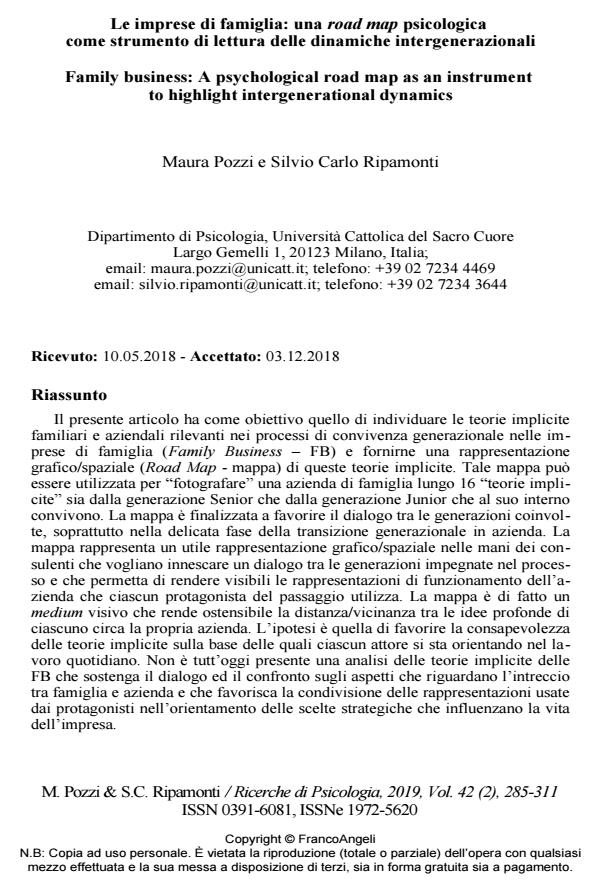Family business: A psychological road map as an instrument to highlight intergenerational dynamics
Journal title RICERCHE DI PSICOLOGIA
Author/s Maura Pozzi, Silvio Carlo Ripamonti
Publishing Year 2019 Issue 2019/2
Language Italian Pages 27 P. 285-311 File size 364 KB
DOI 10.3280/RIP2019-002004
DOI is like a bar code for intellectual property: to have more infomation
click here
Below, you can see the article first page
If you want to buy this article in PDF format, you can do it, following the instructions to buy download credits

FrancoAngeli is member of Publishers International Linking Association, Inc (PILA), a not-for-profit association which run the CrossRef service enabling links to and from online scholarly content.
The aim of the present paper is to identify the implicit theories of the generational processes in family businesses (Family Business - FB), providing a graphical/ spatial representation (map). This map can be used to picture a FB along 16 "key categories" both from Senior and Junior living into FB. The aim of the map is to promote a dialogue between the generations involved, especially in the delicate phase of the generational transition inside the firm. The map is a useful tool that consultants can use to trigger a dialogue between the generations involved in the process: it also makes visible the representations of operation of the firm that each protagonist of the generational transition uses. The graphic/spatial representation of the map is its strong point. It is indeed a visual medium that makes clear the distance/closeness between the deep ideas of each one about his/her company. The hypothesis is to promote awareness about the representations that each actor uses orienting him/herself in his/her daily work. It is not yet present a study of the implicit theories of the FB that supports the dialogue and the comparison on the aspects about the interweaving between family and firm, and that supports the sharing of the representations used by the protagonists in the orientation of the strategic choices that influence the life of the firm.
Keywords: Family business, change, implicit theories, generational transition.
- Organisational Welfare in Italian SMEs: The Process of Valorising Human Resources Chiara D’Angelo, Diletta Gazzaroli, Caterina Gozzoli, in Sustainability /2020 pp.9318
DOI: 10.3390/su12229318 - Generation and Gender Differences in Family Businesses: A New Psychological Perspective Maura Pozzi, Carlo Pistoni, Silvio Carlo Ripamonti, Amalia De Leo, in Journal of Family and Economic Issues /2023 pp.919
DOI: 10.1007/s10834-022-09881-w
Maura Pozzi, Silvio Carlo Ripamonti, Le imprese di famiglia: una road map psicologica come strumento di lettura delle dinamiche intergenerazionali in "RICERCHE DI PSICOLOGIA " 2/2019, pp 285-311, DOI: 10.3280/RIP2019-002004